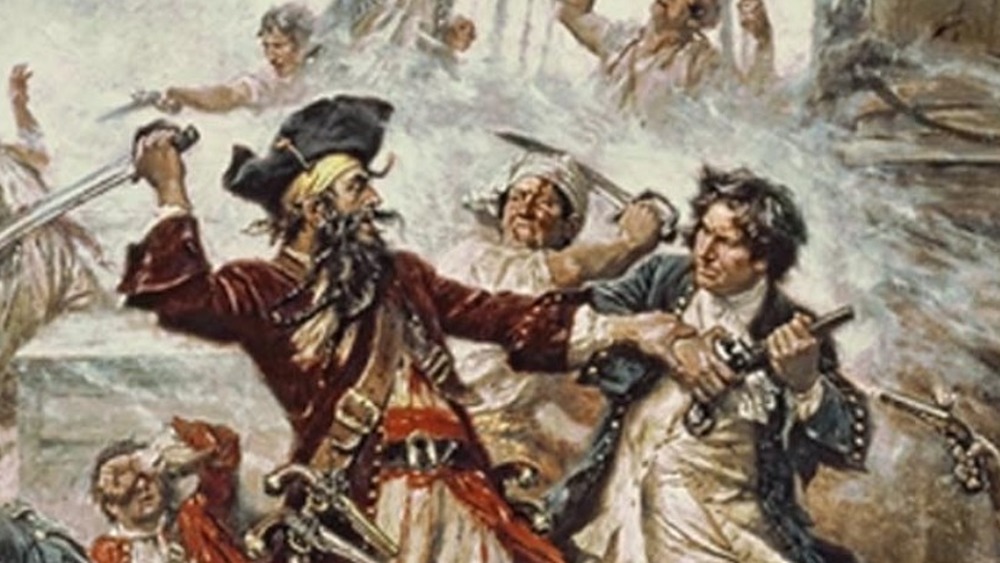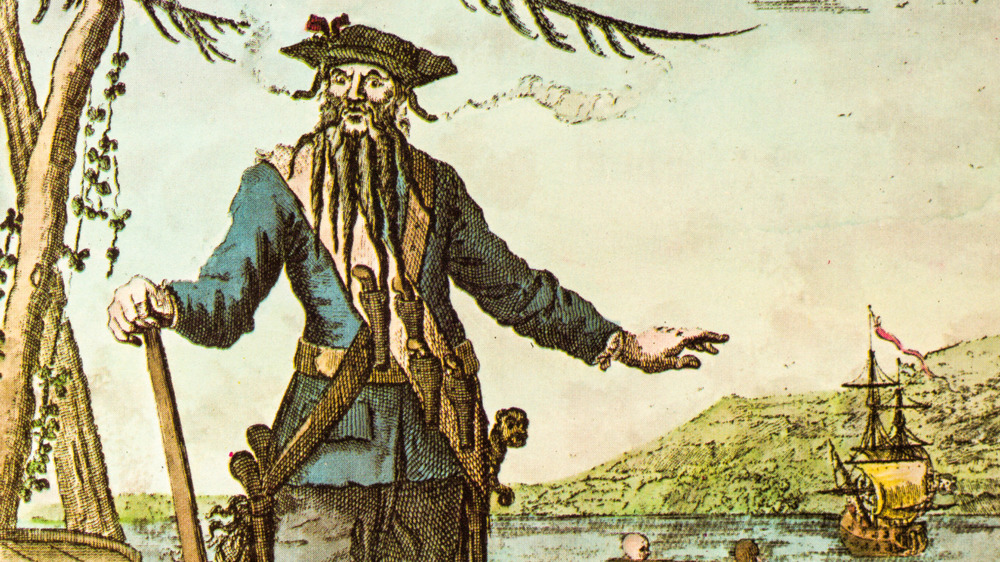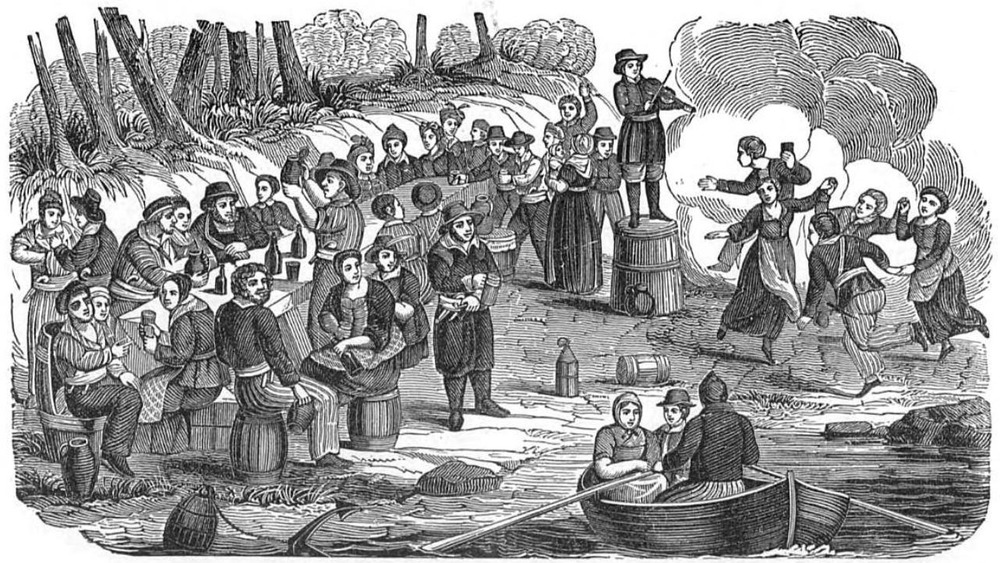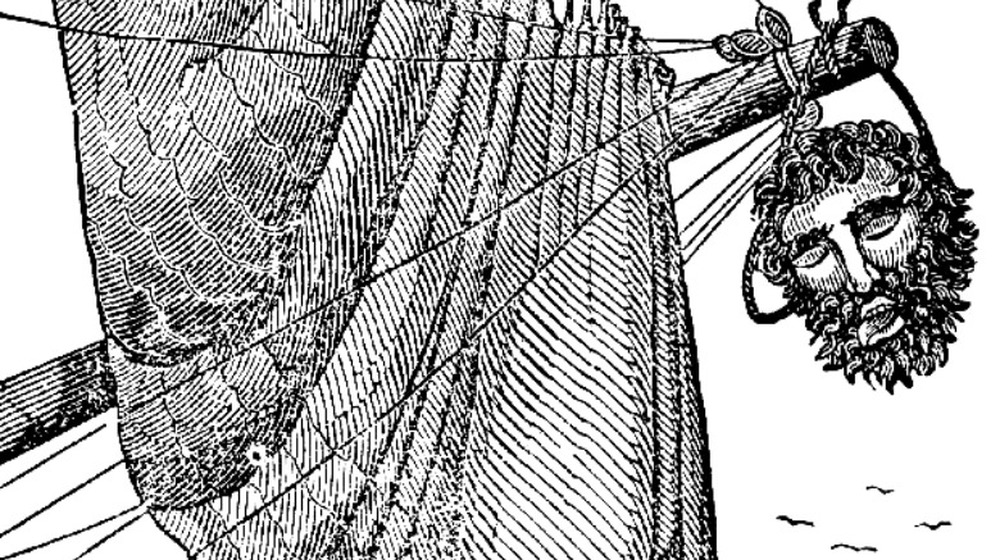The Unknown Story Of Blackbeard's Reformed Civilian Life
Arguably the most famous real-life pirate of all time was Edward Teach, known better by his colorful nom de guerre, Blackbeard. For a period of only a few years in the early 18th century, the final leg of the era known as the Golden Age of Piracy, Blackbeard was the scourge of the Atlantic coast of the North American colonies and the West Indies. Blackbeard's reputation for terrifying behavior — like sticking lit fuses in his hat and beard to frighten his enemies — made his name and that of his ship, the Queen Anne's Revenge, synonymous with the threat of piracy, even though Blackbeard's theatrics were actually his means of avoiding having to resort to actual violence. Despite his fame and notoriety, what most people don't know about Blackbeard is that he actually tried to reform from piracy and live a civilian life in North Carolina. It didn't take, but hey, he gave it a go.
The thing that made civilian life even an option for an infamous rogue like Edward Teach was the Act of Grace, which the Queen Anne's Revenge Project explains was an offer of clemency and full pardon for pirates who voluntarily retired in an attempt to suppress the out-of-control pirate plague afflicting colonial shores. There was also the opportunity of cash rewards for reformed pirates who aided the colonies in capturing those who refused to surrender, as well as for those who turned in their own captains.
The wreck of the Queen Anne's Revenge
On June 10, 1718, Blackbeard's famed ship, the Queen Anne's Revenge, ran aground on a sandbar near modern-day Beaufort, North Carolina. According to the Queen Anne's Revenge Project, it's unclear whether this was accidental or intentional. A member of Blackbeard's crew, David Herriot, testified in a later piracy trial that Blackbeard had intentionally run his ship aground, with the intent of breaking up his crew, taking his money for himself, and getting out of there. Herriot says four ships from Blackbeard's fleet, including Herriot's former ship the Adventure and a Spanish sloop they had just captured in the Caribbean, entered the Beaufort Inlet, after which the Queen Anne's Revenge became stuck. When the Adventure went to help, it became stuck as well. The ships were damaged beyond repair by the wrecks, leaving only the Spanish sloop and the fourth ship, confusingly also named the Revenge, seaworthy.
Blackbeard marooned the majority of his crew, including Herriot, on a nearby shoal, and took a hand-selected group of men in the sloop toward Bath, North Carolina, to seek a pardon from Governor Eden. The captain of the Revenge, Stede Bonnet, had already gone ahead to receive the King's Pardon from Eden. Convinced now that the pardon wasn't a trick, Blackbeard and his select crew members went to Bath in June 1718 to receive their pardon from Governor Eden, leaving Bonnet to return to the inlet to retrieve his ship and the marooned men of Blackbeard's crew.
Yo ho, yo ho, the married life for Blackbeard
Little is known about exactly what Edward Teach got up to in the brief period when he decided to hang up his Blackbeard persona and chill in North Carolina for a little bit, but some sources indicate that he tried to make a go of civilian life by getting married and settling down. While popular legend says that Blackbeard had 14 wives over the course of his life, The Way of the Pirates explains that only one of these wives was a legal marriage, although very little is known about this marriage either. The sources on this marriage say Teach was wedded to Mary Ormond, the young daughter of a Bath plantation owner named William Ormond. Some sources say Mary was 16 at the time of the wedding, while others say she was 14 and soon pregnant, though there's no actual documentation on her age or any children. (It's worth noting here that Teach would have been in his late 30s at this time.)
Despite attempting to appear to double down on domestic life — with the wedding ceremony reportedly performed by Governor Eden himself — Teach never really gave up on piracy. He divided his time between his official home with his wife in Bath and his camp at Ocracoke Inlet, where his crew and his remaining sloop were stationed. Mary Ormond's fate as Blackbeard's wife is unknown, though legend says that Blackbeard offered her as a gift to his crew.
The eventful and brief retirement of Edward "Blackbeard" Teach
As the Queen Anne's Revenge Project explains, the relationship between Blackbeard and Governor Charles Eden was a tenuous one. Obviously the governor didn't want a notorious criminal living in his town, but he also knew that Blackbeard's presence offered Bath a certain amount of protection as well as the potential for financial gain if Eden was willing to look the other way on certain things. As such, it is believed that Eden permitted quite a bit of shady behavior from his most notorious citizen. From his base camp in Ocracoke, Blackbeard staged all manner of extremely pirate-like activities while officially not being a pirate anymore, including looting rowboats and pillaging English and, most notably, two French ships. In this instance, he loaded all the crew from one ship to the other and sailed the remaining ship back to Ocracoke. When confronted about this, Blackbeard told Eden that the ships were derelicts he had found, and all the goods he had taken were just salvage. This became the official story, and Eden walked away with 60 hogsheads of sugar from the French cargo.
Teach's continued criminal activities made the local planters extremely nervous, and before long they had contacted Alexander Spotswood, the governor of the neighboring colony of Virginia, who hated pirates. This marked the beginning of the end for Blackbeard, as it was in a final pitched battle against Spotswood's forces at Ocracoke Inlet that Edward Teach lost his life — and his head — just a few short months after he had allegedly left the pirate's life behind him.



